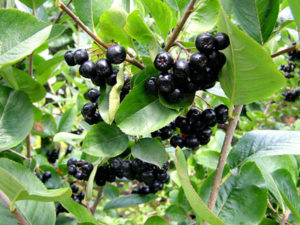 |
| Aronia melanocarpa ‘Viking.’ English photo. |
By Roberta Bailey
New England is rich in plant medicine, and learning that our medicine cabinet just expanded is exciting. Have you heard about the new super fruit? It appears to be better than all the others that have been touted in the last decade. And the best part is that it may be growing in your hedgerow or back fields.
Black chokeberry or Aronia melanocarpa is poised to become the next popular super food.
Black chokeberry is a hardy deciduous bush from the Rosaceae family. Native to eastern North America, it has been popular in Russia and Europe and has lately been getting attention in the United States.
The deep purple berries of Aronia are high in polyphenols and in the category of antioxidants called anthocyanins. They have greater antioxidant levels than blueberries, strawberries, pomegranate, goji, cherry or mangosteen. These compounds present in this native berry can stimulate circulation, protect the urinary tract and strengthen the heart.
Even more exciting are a number of specific agents including, according to medicinal plant expert Chris Kilham, caffeic acid, cyanidin-3-galactoside, malvidin, delphinidin and epicatechin. In combination, these specific agents in Aronia are antibacterial, antiviral and anti-diabetic, says Kilham. They fight the formation of arterial plaque, lower serum cholesterol and protect the liver. For diabetics, these compounds can help lower blood sugar and improve the natural ability of the body to produce its own insulin.
Aronia also contains several cancer- and tumor-fighting compounds that are also proving to fight cardiac diseases, Crohn’s disease, reduce symptoms of PMS, inhibit HIV and fight herpes.
Researchers S. V. Valcheva-Kuzmanova and A. Belcheva say, “Our investigations have demonstrated a remarkable hepatoprotective [liver protective], a very good gastroprotective and a pronounced anti-inflammatory effect of Aronia melanocarpa fruit juice in rats as well as a bacteriostatic activity in vitro against Staphylococcus aureus and Escherichia coli and an antiviral activity against type A influenza virus.”
Of the three Aronia species, A. melanocarpa, A. arbutifolia and A. x prunifolia, A. melanocarpa has the most medicinal properties, while A. arbutifolia lends itself more to culinary uses.
All are small, open, rounded shrubs from 3 to 8 feet tall with some degree of suckering. They can spread from 6 to 10 feet. In early summer they sport clusters of attractive small white flowers, which later form pendulous clusters of berries, each about the size of a blueberry, on red pedicels (stems). Aronia melanocarpa ripens deep black, glossy berries, while A. arbutifolia has red berries. A. x prunifolia, thought to be a natural hybrid of those two species, ripens to black. All three have brilliant red foliage in the fall.
The shrubs thrive in any soil type and are hardy to zone 3 or 4. They make good windbreak or naturalizing and wildlife plants. They tolerate moist soils well. Although tolerant of partial shade, they need at least half a day of full sun to set a good crop of berries. They tolerate wind, salt, pollution and compaction and are relatively disease- and insect-free. Bushes start to fruit at three years of age and reach full fruit production and height by five years.
Chokeberries are available commercially. (Fedco Trees lists numerous cultivars and seedlings.) They can be propagated from seed, cuttings, by layering or by digging up suckers.
Seed is best planted in pots or in a nursery bed in fall and left to stratify (remain cold and moist) over winter.
Take cuttings from dormant plants in early spring and place them in water with a rooting compound. Once roots sprout, place the rooted cuttings in a protected nursery row or pot them.
To layer from an existing bush, simply bend a branch to the ground in spring, scrape the bark off the bottom side, 6 inches or so below the tip of the branch, where it will touch the bare ground. Using a rock or brick, weigh down the section of branch that is scraped. The tip of the branch should stick up above the soil. After the branch roots, snip it from the mother plant and dig the newly rooted plant.
Aronia berries are bland and slightly mealy, although not offensive. They have small seeds. If not picked when fresh, the berries dry on the bush and persist until late winter, when birds eat them. They can be eaten fresh, put into smoothies or made into juice or jam. I combine them with other berries to add a supportive flavor. Blackberry-chokeberry juice and jelly are delicious. Blueberry-chokeberry jam is a very flavorful, anthocyanin-rich spread.
Chokeberries can also be frozen and used all year, added to smoothies or pies, etc. Simply put them in a freezer bag with no extra processing.
They also dry well. Sometimes I pop a few dried berries into my tea and chew them as I drink, my little floating immuno-support medicine cabinet.
References
“Aronia: The North American Super Berry with Cancer Fighting Properties,” by Chris Kilham, https://medicinehunter.com/aronia-north-american-super-berry-cancer-fighting-properties
“Current Knowledge of Aronia melanocarpa as a Medicinal Plant,” by S. V. Valcheva-Kuzmanova and A. Belcheva, Folia Med (Plovdiv). 2006;48(2):11-7; abstract at www.ncbi.nlm.nih.gov/pubmed/17408071
The Fedco Trees 2015 catalog offers Aronia arbutifolia and A. melanocarpa cultivars and seedlings. www.fedcoseeds.com/trees/search?cat=Chokeberries

